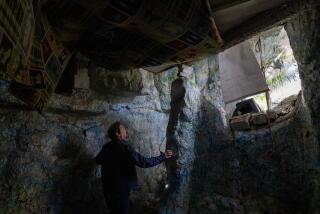Exploring Mitchell Caverns in Providence Mountains State Recreation Area
Reporting from the Providence Mountains State Recreation Area, Calif.
There’s Down Under, like the story on New Zealand on the left side of this page, and then there’s down under.
I chose the latter. Like that journey, my trip to the Providence Mountains State Recreation Area, about four hours east of Los Angeles, introduced me to a world I’d never experienced. And because this is California, the colorful subterranean wonderland of the area’s Mitchell Caverns come with a story that’s tailor-made for the movies.
But first, there was a bit of comedy. At the Providence visitors center, a ranger warned me to watch out for the baby rattlers behind me, not surprising since we were in the Eastern Mojave. When I turned around, I found a barrel full of — you guessed it — baby rattles.
Groan.
But the talk about the caverns soon turned serious: These limestone caves, the danger said, were already ancient by the end of the Pleistocene epoch, perhaps 100,000 years ago, created when groundwater with high mineral content dissolved sedimentary and metamorphosed limestone.
The Chemehuevi people occupied these caves for centuries, considering them sacred and using them for ceremonies as represented by the blackened ceilings from their ancient fires. Because of this religious aspect, the Chemehuevi did not deface the caverns with pictographs or petroglyphs that grace many other such caves, but the surrounding hillside was littered with carved rocks, a living encyclopedia of the people who once lived here.
PLANNING YOUR TRIP
THE BEST WAY TO MITCHELL CAVERNS
From Los Angeles, take Interstate 10 east to Interstate 15 north to Interstate 40 east. The caverns are in the Providence Mountains State Recreation Area in the eastern Mojave Desert, 116 miles east of Barstow and 16 miles northwest of Interstate 40 near Essex Road. The recreation area is surrounded by the Mojave National Preserve.
WHAT TO DO
The recreation area and visitors center are closed Sunday through Thursday, with cavern tours on Saturday and Sunday at 1:30 p.m. For groups of 10 or more, reservations are required three weeks in advance, with a limit of 25 persons a tour. Call (760) 928-2586 for reservations. Adults are $6, $3 for children 6 to 16. Not recommended for ages 5 and younger.
If you wish to camp, there are six campsites, with tables, fire rings and barbecues, at the visitors center for $12 a night.
TO LEARN MORE
https://www.parks.ca.gov/?page_id=25146
My tour group reached the cavern entrance, which resembles two large eyes in the rock, after a meandering half-mile-long trail that offers panoramic views all the way to the Nevada state line. I stepped lightly along the trail, knowing it was also home to several insects found nowhere else in the world. A large multicolored lizard darted in front of me and stopped to do pushups for my camera.
Jack Mitchell, for whom these caverns are named, was an entrepreneur with businesses in Arizona and Los Angeles and had visited the caverns early in the 20th century. When he lost his life savings in the stock market crash of 1929, he and his wife, Ida, retreated to the desert for a simpler life.
Mitchell could not buy the caverns outright, so he sidestepped the law by buying up the local mineral rights around them, effectively giving him control.
He explored them by using a canvas sling chair and rope to lower himself into the black depths. He built a small house out of local volcanic rock and decided to capitalize by adding a guesthouse and charging $1 a night for a room, with a 50-cent chicken dinner thrown in, and guiding visitors into the caverns by torch light.
After his death, the caverns became part of the California State Park system in 1956. Jack and Ida’s house is now the visitor center, and the guest cabin is now a residence for park personnel.
The two sets of caverns made me feel as though I had entered a movie set. Surreal sculptures snaked their way down from the towering roof or ascended majestically from the floor, forming towers, pillars and chandelier-like protrusions. The towering domed roof spread majestically overhead, and I craned my neck as fleet little bats zipped past. If you look long enough in the dimly lighted rooms, as I did, you may start to see faces and familiar objects in the rocks.
Because of the caverns’ fragility, I was reminded several times to stay on the path and not to touch anything. Even the oils from a tap of a finger can have long-range consequences in such an environment.
They have already suffered some damage. The caverns appeared briefly in the 1991 Oliver Stone movie “The Doors,” but because “ancient” petroglyphs were added that proved impossible to remove, filming is no longer allowed.
A concrete path linking the caverns made my excursion easy for the most part, but I had to suck in the old stomach to get through a couple of tight spots. Girth aside, anyone can make the trip, with no spelunking experience necessary. A third cavern, not part of the tour, requires permits, a ranger guide, equipment and technical climbing skills because it is entered by a 300-foot drop.
Visitors can visit the caverns only with a ranger, and there is just one trip a day so reservations are required. The tour takes about 90 minutes, about half of which are taken up by the ranger’s lecture. The actual walk-through will take about 45 minutes.
More to Read
Sign up for The Wild
We’ll help you find the best places to hike, bike and run, as well as the perfect silent spots for meditation and yoga.
You may occasionally receive promotional content from the Los Angeles Times.






